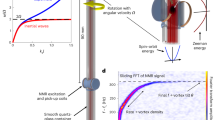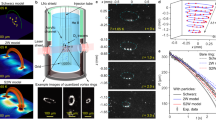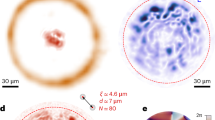Abstract
At the interface between two fluid layers in relative motion, infinitesimal fluctuations can be exponentially amplified, inducing vorticity and the breakdown of laminar flow. While shear flow instabilities in classical fluids have been extensively observed in various contexts, controlled experiments in the presence of quantized circulation are quite rare. Here we observe how the contact interface between two counter-rotating atomic superflows develops into an ordered circular array of quantized vortices, which loses stability and rolls up into vortex clusters. We extract the instability growth rates and find that they obey the same scaling relations across different superfluid regimes, ranging from weakly interacting bosonic to strongly correlated fermionic pair condensates. Our results establish connections between vortex arrays and shear flow instabilities, suggesting a possible interpretation of the observed quantized vortex dynamics as a manifestation of the underlying unstable flow. Moreover, they open the way for exploring out-of-equilibrium phenomena such as vortex matter phase transitions and the spontaneous emergence and decay of two-dimensional quantum turbulence.
This is a preview of subscription content, access via your institution
Access options
Access Nature and 54 other Nature Portfolio journals
Get Nature+, our best-value online-access subscription
$29.99 / 30 days
cancel any time
Subscribe to this journal
Receive 12 print issues and online access
$209.00 per year
only $17.42 per issue
Buy this article
- Purchase on Springer Link
- Instant access to full article PDF
Prices may be subject to local taxes which are calculated during checkout




Similar content being viewed by others
Data availability
The data that support the figures within this paper are available from the corresponding author upon reasonable request. Source data are provided with this paper.
References
Charru, F. Hydrodynamic Instabilities (Cambridge Univ. Press, 2011).
von Helmholtz, H. Über discontinuierliche Flüssigkeits-Bewegungen [On the discontinuous movements of fluids]. Monats. Königl. Preuss. Akad. Wiss. Berlin 23, 215–227 (1868).
Thomson, W. XLVI. Hydrokinetic solutions and observations. Lond. Edinb. Dubl. Philos. Mag. J. Sci. 42, 362–377 (1871).
Rayleigh, L. On the stability, or instability, of certain fluid motions. Proc. London Math. Soc. s1-11, 57–72 (1879).
Drazin, P. G. & Reid, W. H. Hydrodynamic Stability 1–31 (Cambridge Univ. Press, 2004).
Klaassen, G. P. & Peltier, W. R. The onset of turbulence in finite-amplitude Kelvin–Helmholtz billows. J. Fluid Mech. 155, 1–35 (1985).
Mashayek, A. & Peltier, W. R. The ‘zoo’ of secondary instabilities precursory to stratified shear flow transition. Part 2 The influence of stratification. J. Fluid Mech. 708, 45–70 (2012).
Thorpe, S. A. Transitional phenomena and the development of turbulence in stratified fluids: a review. J. Geophys. Res. 92, 5231–5248 (1987).
Thorpe, S. A. On the Kelvin–Helmholtz route to turbulence. J. Fluid Mech. 708, 1–4 (2012).
Reynolds, O. XXIX. An experimental investigation of the circumstances which determine whether the motion of water shall be direct or sinuous, and of the law of resistance in parallel channels. Philos. Trans. R. Soc. Lond. 174, 935–982 (1883).
Thorpe, S. A. A method of producing a shear flow in a stratified fluid. J. Fluid Mech. 32, 693–704 (1968).
Kent, G. I. Transverse Kelvin–Helmholtz instability in a rotating plasma. Phys. Fluids 12, 2140–2151 (1969).
Shearer, E. & Früh, W.-G. Kelvin–Helmholtz instability in a continuously forced shear flow. Phys. Chem. Earth B 24, 487–492 (1999).
Bennemann, K.-H. & Ketterson, J. B. Novel Superfluids Vol. 2 (Oxford Univ. Press, 2014).
Korshunov, S. E. Analog of Kelvin–Helmholtz instability on a free surface of a superfluid liquid. J. Exp. Theor. Phys. 75, 423–425 (2002).
Volovik, G. E. On the Kelvin–Helmholtz instability in superfluids. J. Exp. Theor. Phys. 75, 418–422 (2002).
Takeuchi, H., Suzuki, N., Kasamatsu, K., Saito, H. & Tsubota, M. Quantum Kelvin–Helmholtz instability in phase-separated two-component Bose–Einstein condensates. Phys. Rev. B 81, 094517 (2010).
Suzuki, N., Takeuchi, H., Kasamatsu, K., Tsubota, M. & Saito, H. Crossover between Kelvin–Helmholtz and counter-superflow instabilities in two-component Bose–Einstein condensates. Phys. Rev. A 82, 063604 (2010).
Lundh, E. & Martikainen, J.-P. Kelvin–Helmholtz instability in two-component Bose gases on a lattice. Phys. Rev. A 85, 023628 (2012).
Kokubo, H., Kasamatsu, K. & Takeuchi, H. Pattern formation of quantum Kelvin–Helmholtz instability in binary superfluids. Phys. Rev. A 104, 023312 (2021).
Blaauwgeers, R. et al. Shear flow and Kelvin–Helmholtz instability in superfluids. Phys. Rev. Lett. 89, 155301 (2002).
Finne, A. P. et al. Dynamics of vortices and interfaces in superfluid 3He. Rep. Progr. Phys. 69, 3157–3230 (2006).
Mukherjee, B. et al. Crystallization of bosonic quantum Hall states in a rotating quantum gas. Nature 601, 58–62 (2022).
Baggaley, A. W. & Parker, N. G. Kelvin–Helmholtz instability in a single-component atomic superfluid. Phys. Rev. A 97, 053608 (2018).
Giacomelli, L. & Carusotto, I. Interplay of Kelvin–Helmholtz and superradiant instabilities of an array of quantized vortices in a two-dimensional Bose–Einstein condensate. SciPost Phys. 14, 025 (2023).
Aref, H. On the equilibrium and stability of a row of point vortices. J. Fluid Mech. 290, 167–181 (1995).
Havelock, T. LII. The stability of motion of rectilinear vortices in ring formation. Lond. Edinb. Dubl. Philos. Mag. J. Sci. 11, 617–633 (1931).
Kwon, W. J. et al. Sound emission and annihilations in a programmable quantum vortex collider. Nature 600, 64–69 (2021).
Del Pace, G. et al. Imprinting persistent currents in tunable fermionic rings. Phys. Rev. X 12, 041037 (2022).
Eckel, S., Jendrzejewski, F., Kumar, A., Lobb, C. J. & Campbell, G. K. Interferometric measurement of the current-phase relationship of a superfluid weak link. Phys. Rev. X 4, 031052 (2014).
Kanai, T., Guo, W. & Tsubota, M. Merging of rotating Bose–Einstein condensates. J. Low. Temp. Phys. 195, 37 (2019).
Thorpe, S. A. The axial coherence of Kelvin–Helmholtz billows. Q. J. R. Meteorol. Soc. 128, 1529–1542 (2002).
Warren, B. E. X-Ray Diffraction 206–210 (Dover, 1990).
Griffin, A., Nikuni, T. & Zaremba, E. Bose-Condensed Gases at Finite Temperatures (Cambridge Univ. Press, 2009).
Villermaux, E. On the role of viscosity in shear instabilities. Phys. Fluids 10, 368–373 (1998).
Betchov, R. & Szewczyk, A. Stability of a shear layer between parallel streams. Phys. Fluids 6, 1391–1396 (1963).
Kopnin, N. B. Vortex dynamics and mutual friction in superconductors and Fermi superfluids. Rep. Progr. Phys. 65, 1633 (2002).
Sonin, E. B. Dynamics of Quantised Vortices in Superfluids 43–77; 213–267 (Cambridge Univ. Press, 2015).
Silaev, M. A. Universal mechanism of dissipation in Fermi superfluids at ultralow temperatures. Phys. Rev. Lett. 108, 045303 (2012).
Barresi, A., Boulet, A., Magierski, P. & Wlazłowski, G. Dissipative dynamics of quantum vortices in fermionic superfluid. Phys. Rev. Lett. 130, 043001 (2023).
Allen, A. J., Zaremba, E., Barenghi, C. F. & Proukakis, N. P. Observable vortex properties in finite-temperature bose gases. Phys. Rev. A 87, 013630 (2013).
Mehdi, Z., Hope, J. J., Szigeti, S. S. & Bradley, A. S. Mutual friction and diffusion of two-dimensional quantum vortices. Phys. Rev. Res. 5, 013184 (2023).
Sergeev, Y. A. Mutual friction in bosonic superfluids: a review. J. Low Temp. Phys. https://doi.org/10.1007/s10909-023-02972-4 (2023).
Pikovsky, A. & Politi, A. Lyapunov Exponents (Cambridge Univ. Press, 2016).
Babiano, A., Boffetta, G., Provenzale, A. & Vulpiani, A. Chaotic advection in point vortex models and two-dimensional turbulence. Phys. Fluids 6, 2465 (1994).
Haskell, B. & Melatos, A. Models of pulsar glitches. Int. J. Mod. Phys. D 24, 1530008 (2015).
Price, D. J. & Rosswog, S. Producing ultrastrong magnetic fields in neutron star mergers. Science 312, 719 (2006).
Sachkou, Y. P. et al. Coherent vortex dynamics in a strongly interacting superfluid on a silicon chip. Science 366, 1480–1485 (2019).
Simula, T., Davis, M. J. & Helmerson, K. Emergence of order from turbulence in an isolated planar superfluid. Phys. Rev. Lett. 113, 165302–165302-5 (2014).
Johnstone, S. P. et al. Evolution of large-scale flow from turbulence in a two-dimensional superfluid. Science 364, 1267 (2019).
Gauthier, G. et al. Giant vortex clusters in a two-dimensional quantum fluid. Science 364, 1264–1267 (2019).
Reeves, M. T. et al. Turbulent relaxation to equilibrium in a two-dimensional quantum vortex gas. Phys. Rev. X 12, 011031–011031-18 (2022).
Heyl, M. et al. Vortex dynamics in the two-dimensional BCS–BEC crossover. Nat. Commun. 13, 6986 (2022).
Kobyakov, D., Bezett, A., Lundh, E., Marklund, M. & Bychkov, V. Turbulence in binary Bose–Einstein condensates generated by highly nonlinear Rayleigh–Taylor and Kelvin–Helmholtz instabilities. Phys. Rev. A 89, 013631 (2014).
Barenghi, C. F., Skrbek, L. & Sreenivasan, K. R. Introduction to quantum turbulence. Proc. Natl Acad. Sci. USA. 111, 4647 (2014).
Henn, E. A. L., Seman, J. A., Roati, G., Magalh aes, K. M. F. & Bagnato, V. S. Emergence of turbulence in an oscillating Bose–Einstein condensate. Phys. Rev. Lett. 103, 045301–045301-4 (2009).
Navon, N., Gaunt, A. L., Smith, R. P. & Hadzibabic, Z. Emergence of a turbulent cascade in a quantum gas. Nature 539, 72–75 (2016).
Neely, T. W. et al. Characteristics of two-dimensional quantum turbulence in a compressible superfluid. Phys. Rev. Lett. 111, 235301 (2013).
Acknowledgements
We thank I. Carusotto, N. Cooper and G. Modugno for their valuable comments on the manuscript and the Quantum Gases group at LENS for fruitful discussions. This work was supported by the European Research Council (ERC) under grant agreement no. 307032, the Italian Ministry of University and Research under the PRIN2017 project CEnTraL and PNRR project PE0000023-NQSTI, the European Union’s Horizon 2020 research and innovation programme under the Qombs project FET Flagship on Quantum Technologies grant agreement no. 820419. W.J.K. acknowledges support from the Research Fund (1.220137.01) of UNIST (Ulsan National Institute of Science and Technology). M.M. acknowledges support from grant no. PID2021-126273NB-I00 funded by MCIN/AEI/10.13039/501100011033 and ‘ERDF – A way of making Europe’, and from the Basque Government through grant no. IT1470-22. F.S. acknowledges funding from the European Research Council (ERC) under the European Union’s Horizon 2020 research and innovation programme (grant agreement no. 949438) and from the Italian MUR under the FARE programme (project FastOrbit).
Author information
Authors and Affiliations
Contributions
D.H.-R., G.D.P., F.S., F.M. and G.R. conceived the study. D.H.-R., N.G., G.D.P. and W.J.K. performed the experiments. D.H.-R. and N.G. analysed the experimental data. D.H.-R., K.X., C.F. and M.M. carried out numerical simulations. All authors contributed to the interpretation of the results and to the writing of the manuscript.
Corresponding author
Ethics declarations
Competing interests
The authors declare no competing interests.
Peer review
Peer review information
Nature Physics thanks the anonymous reviewers for their contribution to the peer review of this work.
Additional information
Publisher’s note Springer Nature remains neutral with regard to jurisdictional claims in published maps and institutional affiliations.
Extended data
Extended Data Fig. 1 Reproducibility of the initial cloud preparation.
a, Fidelity in creating the target circulation state state, 〈Δw〉M − ΔwT. b, Number of spurious vortices observed before removing the optical barrier, and c, Deviation of the total number of vortices from the target state, \({\langle {N}_{v}\rangle }_{M}-\Delta {w}_{T}\). All three panels were generated from 100 experimental repetitions for each of the two target states ΔwT = 6, 12 (blue and orange, respectively). d, Total number of vortices detected after removing the barrier, t = 0 of vortex dynamics, as a function of the imprinted winding number difference ΔwT. The red dashed line is the identity line, Nv = Δw.
Supplementary information
Supplementary Information
Supplementary Figs. 1–5 and discussion.
Source data
Source Data Fig. 3
Statistical source data.
Source Data Fig. 4
Statistical source data.
Source Data Extended Data Fig. 1
Statistical source data.
Rights and permissions
Springer Nature or its licensor (e.g. a society or other partner) holds exclusive rights to this article under a publishing agreement with the author(s) or other rightsholder(s); author self-archiving of the accepted manuscript version of this article is solely governed by the terms of such publishing agreement and applicable law.
About this article
Cite this article
Hernández-Rajkov, D., Grani, N., Scazza, F. et al. Connecting shear flow and vortex array instabilities in annular atomic superfluids. Nat. Phys. (2024). https://doi.org/10.1038/s41567-024-02466-4
Received:
Accepted:
Published:
DOI: https://doi.org/10.1038/s41567-024-02466-4



